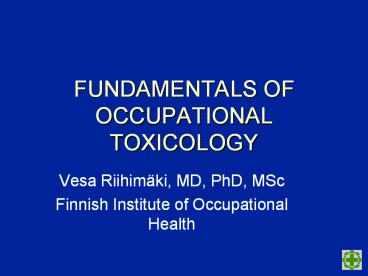FUNDAMENTALS OF OCCUPATIONAL TOXICOLOGY - PowerPoint PPT Presentation
1 / 21
Title:
FUNDAMENTALS OF OCCUPATIONAL TOXICOLOGY
Description:
FUNDAMENTALS OF OCCUPATIONAL TOXICOLOGY Vesa Riihim ki, MD, PhD, MSc Finnish Institute of Occupational Health What do we know of chemical hazards? – PowerPoint PPT presentation
Number of Views:531
Avg rating:3.0/5.0
Title: FUNDAMENTALS OF OCCUPATIONAL TOXICOLOGY
1
FUNDAMENTALS OF OCCUPATIONAL TOXICOLOGY
- Vesa Riihimäki, MD, PhD, MSc
- Finnish Institute of Occupational Health
2
What do we know of chemical hazards?
- We know more than ever, but
- Some 3000 chemicals are classified as dangerous
- New substances and processes are adopted
constantly - Many modern industrial processes depend on
reactive chemicals - The worker is regularly exposed to several
compounds
3
Numbers...
- In the EU, 16 of the workforce has major contact
to dangerous chemicals - Some 5000 chemicals are widely used
- European Chemicals Inventory (EINECS) encompassed
about 100 000 substances (1971-1981), since then
hundreds of new chemicals have been introduced
per year - Complete toxicity data are available for lt1000
chemicals, some data for 20 000 chemicals
4
Basic concepts in toxicology
Intrinsic toxicity
Exposure
HAZARD, RISK
Individual factors
Risk management
5
General principles in chemical safety assessment
- Chemical identity CAS number
- Compound specific, "selective" toxicity
6
? Physical chemical properties
7
? Physical chemical properties, cont'd
8
?Main toxicological data for a chemical
Types of toxicity Toxicokinetics Mode of
action/mechanism of action Dose-effect and
dose-response relationships
9
Types of toxicity - Acute toxicity - Irritancy
and corrosivity - Sensitisation - Repeated dose
toxicity - Mutagenicity - Carcinogenicity -
Reproductive toxicity For most chemicals
toxicity data are based on animal testing results
only.
10
Toxicokinetics Toxicokinetic phases
are absorption, tissue distribution, metabolism,
excretion ABSORPTION Substance specific
properties physical form, particle size, water
solubility, lipid solubility influence absorption
11
Uptake from the respiratory system - particle
size lt 5 µm 5-10 µm gt 10 µm - water solubility
12
Uptake through the skin
Determinants of skin absorption - Compound
properties e.g. water and lipid
solubility, molecular mass, ionic charge -
Vehicle - Occlusion, e.g. "protective" glove -
Anatomic area and individual physiological
factors
13
(No Transcript)
14
Biotransformation, disposition
Chemical may exert toxicity
B) After metabolism to reactive metabolites, for
instance
A) As such, for instance
Cyanide CN-
Toxic Effects
Butadiene
Cyp450
Detoxification to thiocyanate
Reactive epoxide metabolites
URINARY EXCRETION
Glutathione conjugation
15
Elimination and accumulation
Elimination half-time T½ Long elimination
half-time leads to accumulation for instance,
lead (T½ 10 years in cortical bone). Steady
State uptake and excretion are in balance - time
to steady state about 5 x T½
16
Mode of action/mechanism of action
Local effect / Systemic effect Reversible effect
/ Irreversible effect Cumulative toxicity Dose
threshold (deterministic effect) vs. no threshold
(stochastic effect) Mechanism of effect - is it
known?
17
Dose-effect and dose-response relationship lead
decreased erythrocyte delta-ALAD
activity increased zinc protoporphyrin
anemia
CNS effects
decreased peripheral nerve conductivity Nervous
paralysis, lead colics
Adapted from Elinder C-G et al., Biologisk
monitoring av metaller hos människa.
Arbetsmiljöfonden, Uppsala, 1991
18
Importants determinants of exposure
- Subtance concentration / dose of substance
- Duration of exposure
- Dose rate
- Exposure route
19
(No Transcript)
20
Dimethylformamide
21
Individual susceptibility
- Factors underlying susceptibility
- Illnesses and constitutional characteristics,
e.g. allergic predisposition - Individual traits of metabolism that increase
the amounts of active metabolite in the body - Interactions between occupational chemicals or
together with drugs or alcohol

